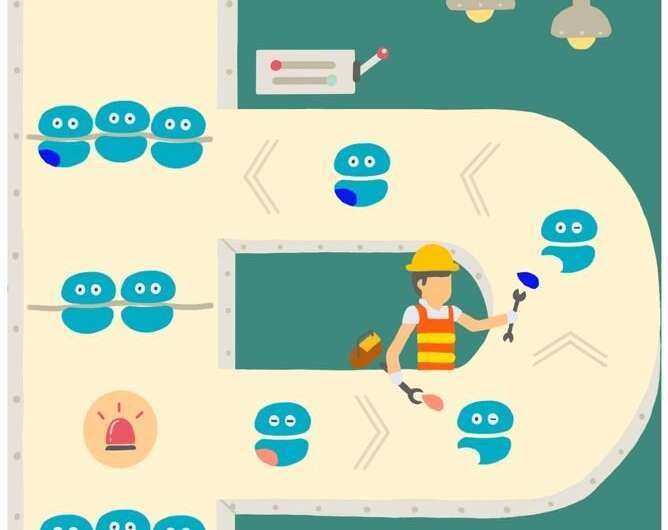This article has been reviewed according to Science X's editorial process and policies. Editors have highlighted the following attributes while ensuring the content's credibility:
fact-checked
peer-reviewed publication
trusted source
proofread
Study: Cells send maintenance crews to fix damaged protein factories

In a discovery fundamental to the inner workings of cells, scientists have discovered that if oxidative stress damages protein factories called ribosomes, repair crews may move in to help fix the damage so work can quickly resume.
The discovery, reported Friday in the journal Molecular Cell, could have implications for cancer, the aging process, and growth and development, said the study's lead author, molecular biologist Katrin Karbstein, Ph.D., a professor at The Herbert Wertheim UF Scripps Institute for Biomedical Innovation & Technology.
"Literally more than half the mass of all cells are ribosomes," Karbstein said. "If you don't have enough ribosomes, or they are malfunctioning, proteins aren't made correctly, and that can lead to all these diseases. We know that defects in the machinery of ribosomes are found in all cancer cells, for example."
In humans, an individual cell may have 10 million ribosomes whirring away, assembling the proteins spelled out in genes, one amino acid at a time. While many things can damage them—infections, ultraviolet light, radiation or oxidative stress—cells have a remarkable ability to protect themselves. Often, the damaged items are tagged for destruction, cut up and recycled. However, because ribosomes are so important to have in large numbers, destroying every damaged ribosome is problematic.
In their study, Karbstein and colleagues found an alternative way, specific to oxidative stress damage. Oxidative stress occurs in cells when highly reactive oxygen molecules produced by the energy metabolism process must find stable places to land. Often those stable places reside within proteins. The introduction of the excess oxygen can change and damage the receiving molecule. In the case of ribosomes, it can totally stop the work of protein building.
The scientists found that ribosomes fix this undesirable damage with helper molecules, which act like chaperones, escorting the damaged segment away from the cell. The damage is quickly fixed, and the ribosome swings back in action. The cell thus avoids the more intensive process of having to break down and recreate entirely new ribosomes, and risk of having a sudden loss of its ribosome pool.
"Typically when proteins are broken, the cell just degrades them. The ribosome is a very large complex of RNAs and proteins, so maybe if a section gets broken you don't want to throw out the whole thing," Karbstein said. "It is like changing a flat tire, rather than buying a new car."
Biochemistry drives the process. Cysteine amino acid molecules in the ribosome are frequent recipients of these free radical oxygen molecules. Oxidative damage changes them enough that if the chaperone molecules are nearby, they prefer to detach from the ribosome and bind instead to the chaperone. As they exit the ribosome, undamaged amino acids move into their rightful places, fixing the breach and restoring protein production.
The biochemical studies were made possible due to discoveries from the lab of chemist Kate Carroll, Ph.D., also at The Wertheim UF Scripps Institute. Carroll's lab developed special reagents and processes for monitoring oxidative damage to cystine amino acids.
The first author on the paper was Karbstein lab postdoctoral researcher Yoon-Mo (Jason) Yang, Ph.D. While the discovery was made in yeast, Yang said, this ribosomal repair system appears to be conserved through many species, including humans. Studies of human neurons have suggested a similar phenomenon, for example.
"All living organisms are subjected to oxidative stress, so protein damage happens in all living things," Yang said. "We suspect that the ribosome repair mechanisms happen in every living thing, including humans."
Going forward, the scientists have many questions to pursue: They found two chaperones; are there more? Many antibiotics disable ribosomes, so do repair mechanisms in bacteria help them evade antibiotics? Yeast cells lacking the chaperones grow poorly and appear less fit, so could this impact aging, growth and development? These are only a few of the questions the discovery raises, Karbstein said.
"I'm thinking about how we can translate this into the aging paradigm," Karbstein said. "It's exactly like filling in a puzzle. You've got this piece, then another, and then you say, 'Oh, that's how all the pieces come together.' So, there are many more pieces to be found."
More information: Yoon-Mo Yang et al, Chaperone-directed ribosome repair after oxidative damage, Molecular Cell (2023). DOI: 10.1016/j.molcel.2023.03.030
Journal information: Molecular Cell
Provided by University of Florida




















